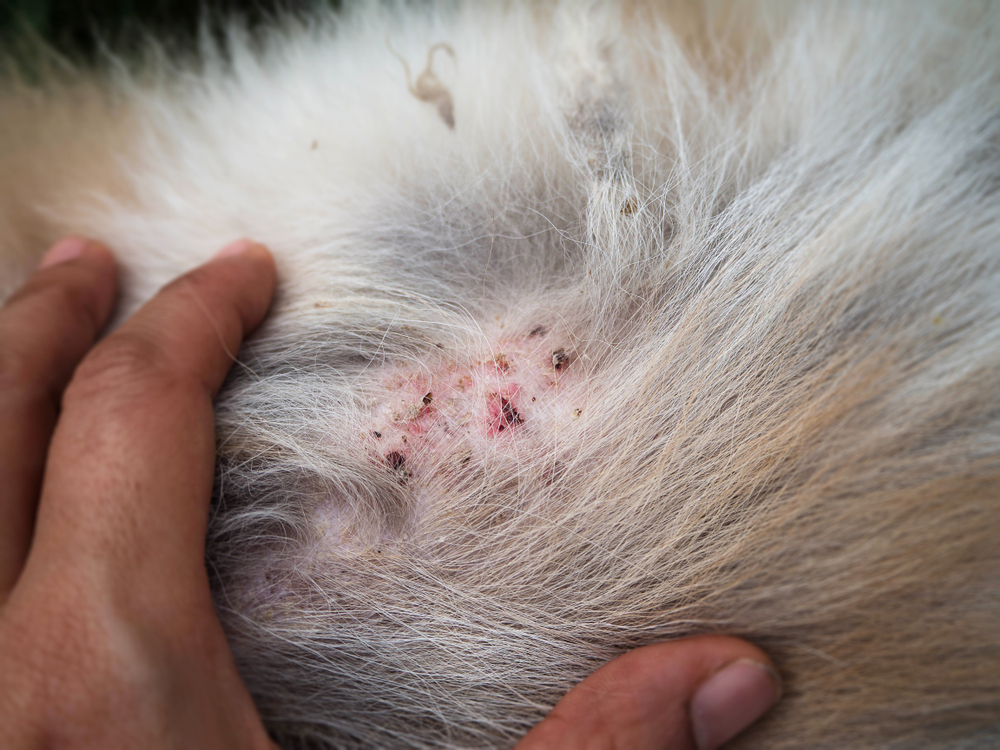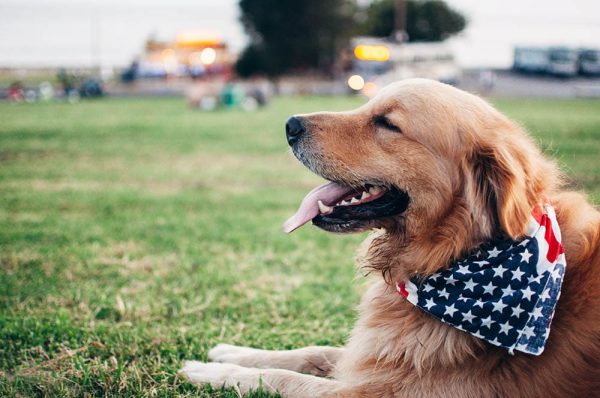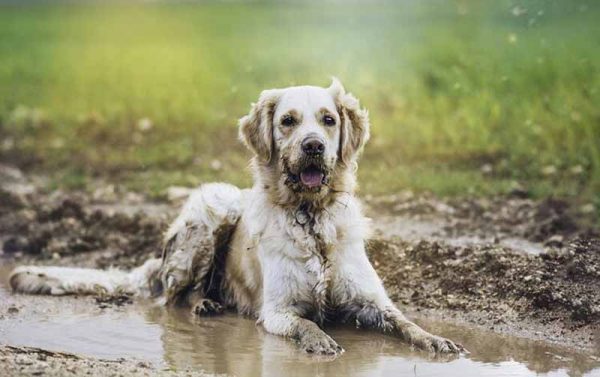If your dog loves to lick you, but their face smells unpleasant, you’re not alone! This is something several dog owners experience. A smelly dog face can be caused by crusty eyes, ear infections, dermatitis, poor dental hygiene, or a dirty coat. Getting your dog to a quality groomer certainly helps, but what about if the smell returns quickly?
Thankfully, you can cure your pup’s stinky face!

The 5 Possible Reasons Your Dog’s Face Smells and How to Get Rid of It
1. Dermatitis

Dermatitis refers to inflammation of the skin, and it can be the cause of a stinky face. It can be a generalized redness to the skin or crusty oozing patches of skin (“hot spots”). Some dogs with dermatitis may have a rash or reaction to something in the environment, while others have underlying allergies. Allergies can be due to pollen, grasses, food, fleas, and mites.
As the skin becomes inflamed, dogs scratch at it to alleviate discomfort. This can break the skin barrier and allow bacteria to enter, causing secondary infections and a nasty smell. Unfortunately, secondary skin infections worsen the itchiness, and the cycle continues unless treatment is initiated. If your dog has unhealthy-looking skin on their face or a bad smell coming from the skin on the face, seeing a veterinarian is a must.
2. Ear Infections
While dogs with big, floppy ears are more prone to ear infections than pointy-eared dogs, any dog can develop an ear infection. Ear infections are a relatively common cause of a smelly dog face, as the yeast or bacteria in the ear canal produce an unpleasant odor. To check if your dog’s ears are the source of its stinky face, you may need to lift the ear and have a smell.
Most dogs with an ear infection show signs of discomfort in addition to the pungent smell. Excessive head-shaking, scratching at the ears, or pressing the ear toward the ground are typical signs. If your dog’s ears are smelly or causing discomfort, we recommend getting them checked by your vet.
Vets examine the ears, inspect the deeper ear canals with an instrument called an otoscope, and often take ear samples to check for bacteria and yeast.
3. Crusty Eyes

Small breeds seem to be more commonly affected by “crusty” eyes. It’s normal for dogs to have a small amount of eye goop in the morning or after a long nap. It’s an accumulation of tears, dust, oils, and dead cells. However, it’s important to clean this material away frequently, as it can dry in the hair beneath the eyes and form a crust. This crust can become irritating to your dog, as well as developing a bad smell.
At home, wiping away the tear build-up before it gets too hard and crusty is a good idea. Always use a gentle, dog-friendly face wipe.
If you are looking for the perfect product to clean your dog's sensitive areas, Hepper's Wash Wipes are our recommendation, plus it's a great on-the-go option. These premium wipes are thick and durable enough for the toughest of paw messes, while still being soft enough to use on your dog's ears or eyes. Formulated with pet-friendly, hypoallergenic ingredients they are the ideal product for all dogs of all ages, skin conditions, or sensitivities.
- Gentle Care For All Pets - Infused with moisturizing hypoallergenic ingredients & enriched with...
- Deep Cleans From Head to Tail - Tackle the toughest dirt & messes with our extra strong pet wipes...
- Freshness On The Go - Each dog grooming wipes pack contains 30 counts of premium dog wipes that...
At Dogster, we’ve admired Hepper for many years and decided to take a controlling ownership interest so that we could benefit from the outstanding designs of this cool pet company!
Another option is a soft cloth dipped into warm water or saline. It’s important to note that while crusty eyes are not related to any disease in some dogs, other dogs have excessive tear production due to eye disorders.
Vets refer to this excessive tear production as epiphora. Epiphora can be caused by blocked tear ducts, conjunctivitis, entropion (an inward-rolling eyelid), and many other issues. If your dog’s eye discharge seems too abundant, or you’re concerned that your dog’s eye seems uncomfortable, you may need a consultation with your veterinarian. They can check for any underlying eye problems and sometimes may need to flush the tear duct under anesthetic.
If you need to speak with a vet but can't get to one, head over to PangoVet. It's our online service where you can talk to a vet online and get the advice you need for your pet — all at an affordable price!
4. Dental Hygiene
Bad breath is one of the most common causes of a smelly dog face. Pet owners often forget to look in their dog’s mouths; furthermore, some dogs don’t like their mouths being looked at, which makes it very hard. When vets talk about poor dental hygiene, they’re often talking about the plaque and calculus buildup on the teeth. This is called periodontal disease, and most dogs have it to some degree. Indeed, some studies suggest that roughly 80% of dogs over the age of three have periodontal disease! Dental plaque makes a great hiding spot for bacteria; as with skin and ear infections, these bacteria are responsible for the bed smell.
So, what can be done to improve your dog’s dental hygiene? It might come as a surprise, but good dental hygiene in dogs starts with daily tooth brushing. Always use pet-grade toothpaste and toothbrush, as human-grade products can be harmful. Another easy and beneficial option is dental chews. These are products designed for your dog to chew on; in theory, the chewing helps break down plaque on the teeth.
However, some dogs won’t tolerate tooth brushing, and other dogs have such advanced periodontal disease that tooth-brushing and dental chews won’t fix the problem. If this is the case, your vet may recommend a dental clean-up under anesthetic.
5. Dirty Coat

Despite the previous causes of a smelly dog face, some dogs just need a good bath! Most dogs are just like people and benefit from a regular wash. Dogs that are keen swimmers, mud-rollers, and bush-walkers are more likely to have a dirty coat. Additionally, dogs that get wet are prone to getting that damp “doggy” smell we often notice. Bathing and grooming frequency varies depending on your dog’s breed and lifestyle, as well as the time of year.
But if you notice a generalized bad dog smell, find a good dog shampoo and give your pup a bath! If this is too hard to do at home, find a good local groomer and let them take care of it for you.
Our Favorite Products
Bathing your dog may be challenging, but selecting the right shampoo can help make the process a bit easier. Our favorite products come from Hepper's Shampoo product line, offering natural, pet-friendly solutions meticulously designed to gently cleanse your dog's skin and coat without any risk of irritating or drying them out. These formulas are free of harmful additives such as dyes, soaps, sulfates, and phthalates. The Deep Cleansing Shampoo is a great option for pet owners who have difficulty neutralizing tough doggy odors. Hepper's Oatmeal Pet Shampoo is a great way to treat your pet to aloe vera and oatmeal's calming benefits while you revel in the delightful and refreshing scents!
| Rating | Image | Product | Details | |
|---|---|---|---|---|
| For Sensitive Pups |

|
Hepper Colloidal Oatmeal Pet Shampoo |
|
Check Price |
| For Smelly Pups |

|
Hepper Deep Clean Shampoo |
|
Check Price |
At Dogster, we’ve admired Hepper for many years and decided to take a controlling ownership interest so that we could benefit from the outstanding designs of this cool pet company!

Conclusion
Don’t let a smelly face get in the way of your canine cuddle time. If you notice your dog’s face smells, check their eyes, ears, skin, and teeth. There’s plenty you can do at home to solve this problem, and your dog will most likely be thankful for it!
If the smell won’t disappear, or if you have any concerns about your dog’s health, don’t hesitate to contact your veterinarian.
Featured Image Credit: sweetlouise, Pixabay





















